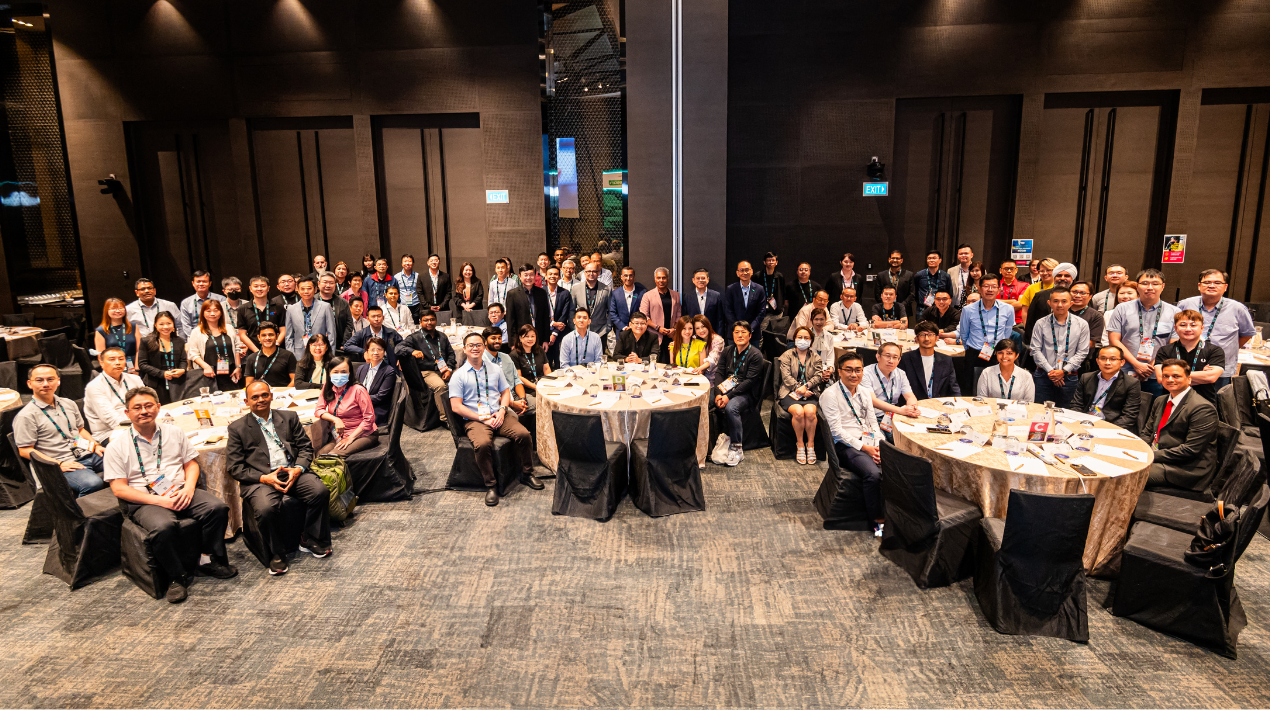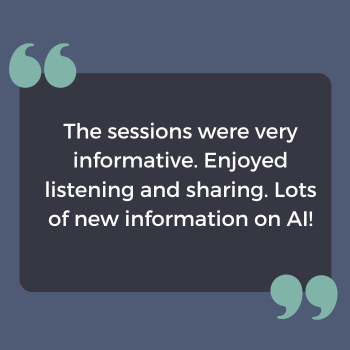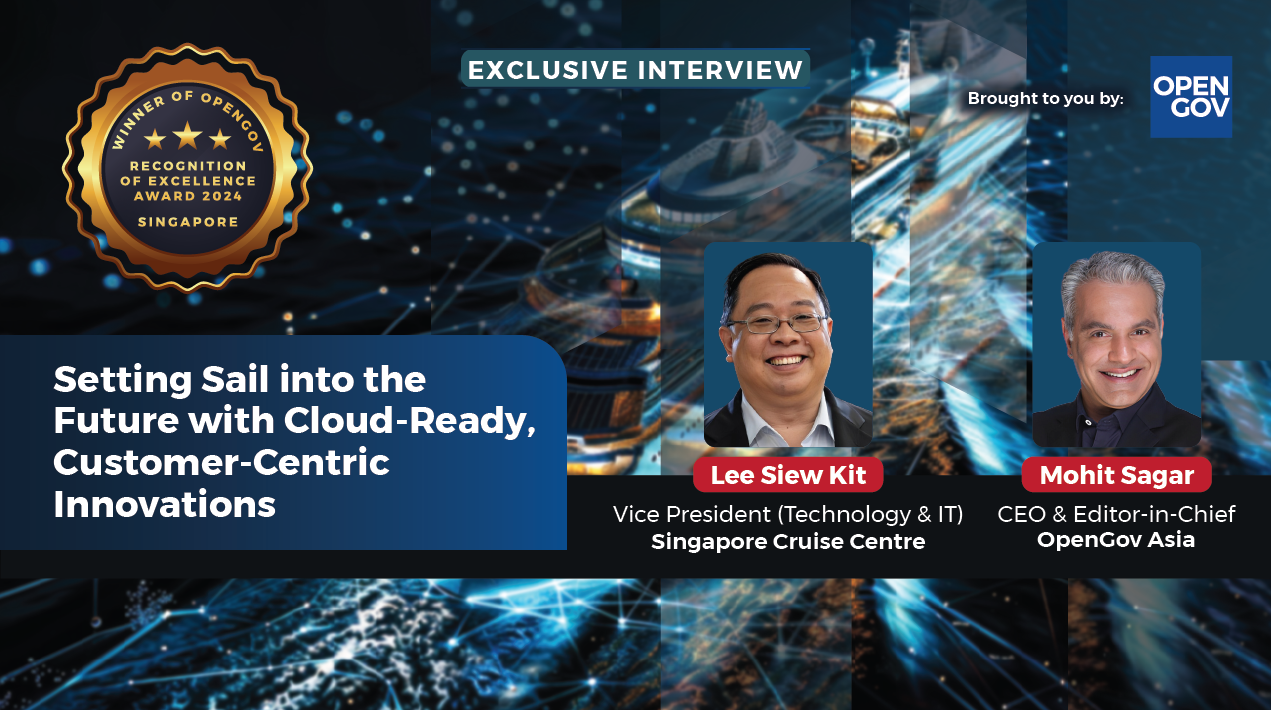
|
Getting your Trinity Audio player ready...
|
Singapore’s digital transformation is marked by the rapid adoption of cutting-edge technologies and innovative solutions across all sectors. From smart city initiatives to robust cybersecurity measures, it leads globally in leveraging digital advancements for economic growth and societal progress.
 The government’s proactive approach, pivotal in driving this transformation, is evident in its plethora of digital initiatives. Artificial intelligence (AI) integration has become ubiquitous within Singapore’s digital sphere, with its implementation spanning critical sectors like healthcare, finance, and the public sector, propelling the nation’s advancement.
The government’s proactive approach, pivotal in driving this transformation, is evident in its plethora of digital initiatives. Artificial intelligence (AI) integration has become ubiquitous within Singapore’s digital sphere, with its implementation spanning critical sectors like healthcare, finance, and the public sector, propelling the nation’s advancement.
Bolstered by endeavours such as AI Singapore and strategic partnerships with industries, Singapore not only enhances operational efficiency but also leads pioneering AI research, solidifying its status as a premier global hub for AI innovation.
AI’s potential to tackle business challenges with unprecedented speed and precision is immense, especially when combined with supercomputing. From optimising complex supply chains to analysing vast datasets for strategic insights, AI-driven supercomputing enables swift, informed decision-making, driving efficiency and innovation to new heights.
However, amid rapid technological adoption, fostering sustainable IT practices is imperative to mitigate environmental impacts and ensure long-term viability. Prioritising energy efficiency, responsible e-waste management, and eco-friendly infrastructure allows organisations to reduce their carbon footprint and contribute to a sustainable future.
According to Hewlett Packard Enterprise, “Sustainable IT can be both a win for the planet and a win for IT organisations”. Cost savings from increased operational efficiency can be reallocated to pioneering and transformative endeavours, enhancing sustainability.
Singapore’s Infocomm Media Development Authority (IMDA) and Government Technology Agency (GovTech) are central to promoting sustainable IT. Their 2024 initiatives aim to revolutionise the ICT sector into an environmentally conscious force while driving broader economic green transformation.
Balancing advanced AI capabilities with ethical considerations and environmental impact is challenging. Agencies in Singapore can adopt strategic initiatives to overcome these challenges, advancing resilience and future-proofing their frameworks.
 AI-driven workload optimisation solutions dynamically adjust resource allocations based on real-time demand. AI algorithms optimise workload placement, migration, and scaling across hybrid IT environments to maximise resource utilisation and minimise energy waste.
AI-driven workload optimisation solutions dynamically adjust resource allocations based on real-time demand. AI algorithms optimise workload placement, migration, and scaling across hybrid IT environments to maximise resource utilisation and minimise energy waste.
Sophisticated management and optimisation tools allow organisations to monitor energy consumption patterns and identify opportunities for enhancement. These tools provide insights into resource utilisation dynamics, empowering organisations to make informed decisions to minimise energy consumption without compromising operational efficacy.
Implementing AI-driven resource management solutions assists in optimising server and storage utilisation. AI platforms analyse workload patterns, predict resource demands, and dynamically allocate resources to reduce energy consumption while maintaining performance.
The OpenGov Event on 23 May 2024 at Novotel Singapore on Stevens delved into strategies for harnessing AI capabilities and fostering sustainable IT. The event provided the latest information and actionable strategies to help businesses enhance operational efficiency, reduce costs, and ensure resilience in the ever-evolving digital landscape.
This closed-door, invitation-only interactive session featured top technology leaders from Singapore, making it a high-impact gathering. Many prominent tech leaders shared insights, discussed challenges and explored opportunities to leverage digital technologies for sustainable growth and competitive advantage.
Welcome Address

Mohit Sagar, CEO and Editor-in-Chief at OpenGov Asia, acknowledges Singapore’s eminent position as a global frontrunner in digital transformation, attributing this status to its swift adoption of cutting-edge technologies spanning diverse sectors. Serving as an exemplary model, Singapore adeptly harnesses digital innovations to drive both economic prosperity and societal progress.
The integration of AI is particularly remarkable in Singapore’s digital landscape, where it is being extensively utilised across sectors. This widespread adoption underscores AI’s transformative potential in enhancing efficiency and driving innovation. For example, AI is revolutionising Singapore’s healthcare sector by enabling more accurate diagnoses, personalised treatment plans, and efficient management of healthcare resources. Through AI-powered predictive analytics, hospitals can anticipate patient admissions, optimise staff schedules, and improve overall patient care.
Singapore’s impressive rise in the Global AI Index rankings is a testament to its commitment to AI development. Surging from 10th place in 2020 to 3rd place in 2023, surpassing the UK, Singapore’s progress indicates a bright future in AI.
Despite the rapid pace of technological advancement, Mohit observes that numerous organisations continue to overlook the importance of prioritising sustainable IT practices. These strategies not only contribute to safeguarding the planet but also enhance productivity, compliance and the overall longevity of organisations.
Highlights the dual benefits of sustainable IT practices, Mohit notes their positive impact on both the environment and organisations. They enhance efficiency and productivity by optimising energy consumption, streamlining processes and minimising waste. Consequently, businesses can operate more effectively, leading to heightened productivity levels and improved overall performance.
“Embracing sustainable IT practices isn’t just about conforming to laws; it’s about future-proofing businesses across industries,” Mohit believes strongly. “Beyond compliance, these practices offer tangible benefits such as cost savings, efficiency and increased profitability as well keeping in line with customers increasing focus on environmental consciousness.”
Mohit advocates for organisations to prioritise sustainable IT practices, underscoring their role in fostering resilience and competitiveness in today’s swiftly evolving digital terrain. A lackadaisical approach can result in both substantial environmental repercussions and endanger long-term organisational continuity.
Investing in sustainable IT practices not only contributes to the long-term success of businesses but also aligns them with sustainable growth models. By reducing their environmental impact and adopting sustainable business strategies, companies position themselves for longevity in an increasingly environmentally conscious world.
“Venturing into AI adoption while neglecting sustainable IT practices jeopardises digital resilience, leaving organisations vulnerable to evolving market dynamics and technological disruptions,” is Mohit’s warning. “Failing to harness AI for innovation in conjunction with an environmentally positive mindset could leave businesses struggling to adapt, innovate, or compete effectively in today’s rapidly shifting landscape.”
Despite the hardships and latency in uptake, Singapore’s future trajectory in AI and sustainability is both promising and exciting. As advancements continue to shape the global landscape, Singapore stands poised to lead the charge in innovation and technology.
Opening Keynote
Business Strategy 2024 and Beyond

Loh Khai Peng, Vice President and Managing Director of SEA & Singapore at Hewlett Packard Enterprise, is convinced that businesses neglecting AI and sustainable IT practices risk being unprepared for market changes and technological disruptions, thereby undermining their digital resilience. Sustainable IT practices are crucial in today’s digital age, particularly when businesses need to integrate AI technology into their systems.
“Adopting AI and sustainable IT practices is more than staying competitive, it’s about ensuring long-term viability and resilience,” Khai Peng elaborates. “Organisations must prioritise both to effectively navigate the ever-evolving market dynamics and technological disruptions.”
Integrating AI across various sectors has shown substantial benefits, including increased efficiency, innovation, and productivity. AI-driven automation streamlines workflows, reduces operational costs, and enhances decision-making processes, leading to higher profitability and faster adaptation to market changes. For instance, AI can predict customer behaviour, optimise supply chains, and personalise marketing strategies, contributing to a more responsive and agile business model.
Businesses that embrace sustainable IT practices are better positioned to comply with environmental regulations, avoid costly fines, and enhance their corporate reputation. Additionally, optimising energy use and reducing waste can lower environmental impact and boost the bottom line. For example, data centres can implement advanced cooling technologies and energy-efficient servers to minimise their carbon footprint.
Additionally, adopting circular economy principles, where electronic waste is recycled and repurposed, reduces environmental impact and creates new economic opportunities. This approach minimises waste, conserves resources, and stimulates secondary markets, driving sustainable development.
Moreover, Khai Peng pointed out that the synergy between AI and sustainable IT practices creates a robust framework for future growth. When organisations integrate AI with sustainable practices, they set themselves up for long-term success, driving innovation while being mindful of their environmental responsibilities. This approach ensures they remain resilient and competitive in an increasingly digital and eco-conscious world.
While the audience concurred that AI is a pivotal tool in modern business strategies, they wanted to know how organisations could best integrate AI technologies to effectively integrate AI technologies to enhance operational efficiency and achieve sustainability goals.
Emphasising the importance of a comprehensive approach to AI integration, Khai Peng explained that AI can analyse and optimise resource usage, from energy consumption in buildings to supply chain logistics, ensuring operations are both sustainable and efficient. This results in reduced costs, minimised waste and enhanced overall performance.
By implementing sustainable practices alongside AI advancements, businesses can achieve a balanced approach that drives growth, safeguards the planet, and future-proofs their operations. This dual focus addresses immediate business needs and contributes to broader societal goals.
“This mindset positions companies as industry leaders, adept at navigating the complexities of the digital era while upholding a strong commitment to environmental stewardship and social responsibility,” Khai Peng believes.
Integrating AI and sustainable IT practices is essential for modern businesses to thrive and ensure long-term viability. Embracing these innovations helps organisations navigate the digital age, drive progress, and maintain a competitive edge in a rapidly evolving market, Khai Peng concludes.
Compute Engineered for Your Hybrid and AI World

Amit Krishna, General Manager of Compute, Southeast Asia at Hewlett Packard Enterprise (HPE), highlighted the hybrid world’s transformative impact on business operations. He acknowledges the transformative power of AI in revolutionising the business landscape and that integrating AI with hybrid infrastructure is essential for organisations to fully harness AI’s potential and maintain their competitive edge. By blending traditional physical infrastructure with modern digital solutions, this approach fosters a more agile, responsive, and efficient operational environment.
Amit believes integrating AI with hybrid infrastructure enables businesses to access advanced analytics, automate processes, and make informed decisions, enhancing overall performance. This combination merges the scalability of cloud services with the customisation of on-premises systems, supporting AI models that analyse large datasets, uncover patterns, and make data-driven decisions effectively.
Furthermore, the fusion of AI with hybrid infrastructure empowers businesses to automate repetitive tasks, freeing human resources for strategic and creative efforts and thereby improving operational efficiency and speed. This integration also provides real-time insights and predictive analytics, helping businesses make strategic, evidence-based decisions to enhance competitiveness.
Amit highlights that this holistic enhancement ensures businesses remain agile and innovative, sustaining growth and maintaining a competitive edge. By incorporating AI with hybrid infrastructure, businesses not only improve current performance but also position themselves for sustained success and innovation in the digital age.
A hybrid paradigm enables organisations to leverage the best of both on-premises and cloud-based systems. Businesses can retain oversight of sensitive data and essential applications while leveraging the scalability, flexibility, and cost-effectiveness of cloud services. He pointed out the hybrid world’s advantages, emphasising its ability to combine the best of both traditional and digital infrastructure.
Enhanced Flexibility and Scalability: By integrating on-premises infrastructure with cloud resources, companies can dynamically scale their IT resources to meet fluctuating demands. This scalability is crucial for managing peak workloads without over-investing in physical infrastructure.
Cost Optimisations: The hybrid approach helps organisations optimise costs by allowing them to pay only for their cloud resources while continuing to utilise existing on-premises investments. This model can lead to significant savings, particularly for businesses with variable workloads.
Improved Data Management and Security: With a hybrid model, businesses can keep sensitive data and critical applications on-premises, with complete control over security measures. At the same time, they can leverage the cloud for less sensitive data and applications, benefiting from the advanced security features cloud providers offer.
Increased Agility and Innovation: The hybrid world fosters innovation by allowing businesses to experiment with new cloud technologies and services without disrupting their operations. This agility enables faster deployment of new applications and services, driving business growth and competitiveness.
Business Continuity and Disaster Recovery: A hybrid approach enhances business continuity and disaster recovery capabilities by ensuring that data and applications can be replicated and backed up across both on-premises and cloud environments. This redundancy helps minimise downtime and ensures businesses can quickly recover from disruptions.
Transitioning to a hybrid model poses significant challenges due to its complexity and the presence of several critical hurdles. Among them is the management of integrating traditional on-premises infrastructure with modern cloud environments, which necessitates meticulous planning and execution to ensure seamless compatibility between systems.
Another significant concern is ensuring interoperability between different systems and platforms. In a hybrid environment, it’s crucial that data and applications can move freely and function consistently across both on-premises and cloud settings. This necessitates robust integration strategies and tools to bridge gaps between disparate systems.
Addressing potential security vulnerabilities is a key issue in the hybrid model. Maintaining a consistent and comprehensive security posture becomes more complex with data and applications spread across multiple environments. Organisations must implement rigorous security measures and continuously monitor for threats to protect their assets.
The importance of having a straightforward strategy to navigate these challenges successfully is vital, says Amit. This strategy should outline specific goals, timelines, and the resources needed to transition smoothly to a hybrid model.
Additionally, working with experienced partners is crucial as they can provide the expertise and support required to manage the complexities of a hybrid environment, ensuring that the integration is both practical and secure.
HPE plays a pivotal role in facilitating this transition by offering comprehensive solutions tailored to seamlessly integrate on-premises and cloud environments. This encompasses a robust computing infrastructure capable of managing hybrid workloads efficiently. With advanced data management tools ensuring accessibility and security, coupled with scalable cloud services, businesses can innovate and grow without limitations.
HPE’s solutions are tailored to empower businesses to build and manage their hybrid ecosystems effectively. By leveraging HPE’s expertise and technology, organisations can create a hybrid environment that maximises performance, optimises costs, and enhances overall business agility.
Amit stressed that the hybrid world signifies not merely a technological shift but a fundamental transformation in business operations and competitiveness in the digital era. The adoption of hybrid solutions empowers organisations to attain unprecedented levels of efficiency, innovation, and resilience.
“By adopting a hybrid approach, businesses can stay agile and responsive to changes, driving growth and maintaining a competitive edge,” he concluded. “This positions them for long-term success in an increasingly complex and dynamic market.”
Simplify Data Management in a Hybrid Cloud World

Marc Wee, General Manager of Storage & Data Services, Southeast Asia at Hewlett Packard Enterprise recognises the pivotal role of data in the evolution of enterprises, emphasising its indispensability in today’s competitive landscape and the imperative nature of digital transformation.
Successful digital transformation requires modernising technology and processes. It necessitates a shift to a data-centric mindset in which data becomes the core; where data is recognised as the key driver of value creation and the organising principle for business success.
“Data is organisational blood. Data permeates all aspects of business, sustaining and driving growth across every sector,” Marc believes. “Like blood, it must be clean and healthy to ensure the vitality and success of the organisation.”
To advance as a data-first business in today’s hybrid cloud world, it is crucial to eliminate obstacles such as management complexity, storage silos, scale-out limitations, and constant firefighting. Instead, organisations need a much less complex operational experience from edge to cloud. Handling mission-critical applications effectively is integral to becoming a data-first organisation.
This approach is supported by the concept of data-first modernisation, which recognises that data, not technology infrastructure or the cloud, is the key to driving today’s IT operating model. It involves unlocking trapped legacy data and capturing the value of all data from the edge to the data centre to the cloud. This strategy is designed to ensure that all data is connected and usable wherever it is located, leveraging analytics and intelligence to architect new processes.
Hewlett Packard Enterprise offers a unique approach to mission-critical storage, delivering a cloud experience everywhere. Breaking away from legacy infrastructure is essential to transform truly, and elevating the storage experience with a platform that provides cloud operations can help maximise efficiency at scale. This ensures that applications are always on and fast, providing the necessary agility for modern businesses.
“HPE Storage is designed to achieve a simple, intuitive self-service cloud experience accessible from anywhere, on any device, through HPE GreenLake for storage,” said Marc. “Utilising a storage-as-a-service solution allows IT staff to focus on strategic initiatives rather than being weighed down by day-to-day operations.”
When asked about the advantages of HPE’s solution, Marc explained that it allows organisations to run all workloads on a modular, disaggregated multiprotocol storage architecture, enabling them to scale capacity and performance independently and non-disruptively while benefiting from cost efficiency.
Standardised composable building blocks can support or be repurposed for various software-defined storage personas and use cases, including block and file storage. This flexibility is crucial in adapting to modern enterprises’ diverse and evolving needs.
By embracing HPE’s innovative solutions, organisations can navigate the complexities of digital transformation, enhance operational efficiency, and position themselves for long-term success in an increasingly dynamic and competitive market.
“We all know that becoming a data-first business requires a comprehensive approach to modernising technology and processes. HPE’s solutions are designed to facilitate this transformation, offering a seamless and efficient operational experience from edge to cloud,” Marc ends. “By leveraging HPE’s expertise and advanced storage solutions, organisations can achieve the agility, efficiency, and resilience needed to thrive in the digital age.”
Panel Session
Driving Operational Excellence and a Resilient Future: Synergising AI Technologies with Sustainable IT Practices
In an era marked by rapid technological advancement and growing environmental concerns, the intersection of artificial intelligence (AI) and sustainable information technology (IT) emerges as a crucial avenue for enhancing efficiency and resilience across various sectors. As organisations seek innovative solutions to address these challenges, leveraging AI-powered sustainable IT can drive forward-thinking strategies that optimise resource utilisation and mitigate environmental impact.
Mohit explains that cutting-edge AI technologies offer unprecedented opportunities to revolutionise sustainability in IT through advanced data analysis, pattern recognition, and predictive analytics.
For example, AI can optimise data centre operations by predicting and managing cooling needs to reduce energy consumption and improve supply chain logistics, ensuring resources are used more efficiently and sustainably.
Moreover, sustainable IT practices supported by AI can play a pivotal role in developing smart cities, where urban environments are managed and operated with a focus on sustainability. These technologies can integrate various urban systems, such as transportation, energy, and waste management, to create more efficient and eco-friendly urban spaces.
Three experts join Mohit in a panel discussion to share their insights on AI and sustainable IT practices, exploring how advanced technologies can drive environmental sustainability and operational efficiency across various sectors.

Dilipkumar B. Khandelwal, Chief Technology Officer for SEA & Singapore at Hewlett Packard Enterprise is convinced that integrating AI into sustainable IT practices allows organisations to better understand their environmental impact. AI-powered analytics can track and report on sustainability metrics, providing a clear picture of progress and identifying areas for further improvement. This data-driven approach enables more informed decision-making and helps organisations set and achieve ambitious sustainability goals.
For example, AI can support the deployment of intelligent transportation systems that minimise traffic congestion and emissions, as well as smart grids that more effectively balance energy supply and demand. These advancements not only contribute to a lower carbon footprint but also enhance the quality of life for city residents.
“Companies can leverage AI to develop products and services that are inherently more sustainable, such as energy-efficient appliances and green building technologies,” confirms Dilip. “These innovations not only open new market opportunities but also provide a competitive edge in an increasingly eco-conscious global market.”
Elaborating on its advantages, Dilip explained that AI has the potential to significantly advance backup storage systems, transform sustainable IT practices, and enhance organisational resilience. He outlined several ways AI can support the development of backup storage systems and highlighted their corresponding benefits:
Optimisation of Storage Efficiency
AI is very effective in optimising storage allocation by analysing data patterns and usage. This tiered approach ensures that frequently accessed data is stored on faster, more accessible media while less frequently accessed data is moved to more cost-effective storage solutions. As a result, resource wastage is minimised, and overall storage efficiency is improved.
Moreover, AI algorithms can identify and eliminate redundant data across storage systems, reducing the space required for backups. Additionally, AI-driven compression techniques further minimise storage needs, lowering costs and reducing environmental impact.
Enhanced Data Protection and Security
AI offers real-time monitoring of storage hardware and software, predicting potential failures before they occur. This proactive approach enables organisations to address issues, minimising data loss and downtime promptly.
Additionally, AI continuously analyses backup data for unusual patterns or anomalies that may indicate cyber threats like ransomware or data corruption. Early detection of such threats allows immediate protective measures to safeguard critical data.
Automation and Streamlining Processes
AI can intelligently schedule backups based on data usage patterns, ensuring they occur optimally to minimise disruption and maximise efficiency. This reduces the manual effort required to manage backup processes.
Furthermore, AI can enable backup systems to self-diagnose and automatically resolve minor issues, reducing the need for human intervention and maintaining system uptime.
Impact on Sustainable IT
By optimising storage allocation and reducing redundant data, AI minimises the energy required for storage and retrieval. Efficient use of storage resources translates to lower power consumption and a reduced carbon footprint.
Predictive maintenance powered by AI helps extend the lifespan of storage hardware by addressing issues before they cause significant damage. This reduces the need for frequent hardware replacements, contributing to sustainability by decreasing electronic waste.
Enhanced Organisational Resilience
AI-driven backup systems can quickly identify and restore critical data, significantly reducing recovery times in the event of data loss or system failures. This ensures business continuity and minimises operational disruptions.
Systems powered by AI continuously learn from incidents and user interactions, improving their response to future threats and failures. This adaptive capability enhances the resilience of backup storage systems over time.
Nonetheless, Dilip states that integrating artificial intelligence (AI) with sustainable information technology (IT) presents several key challenges for organisations. These challenges include investment, maintenance, ensuring data privacy and security and the need for specialised skills.
The high initial costs of implementing AI-powered sustainable IT solutions, along with ongoing management, can be prohibitive for smaller organisations with limited budgets. Additionally, protecting sensitive information is a key challenge, as AI relies heavily on data, especially in the context of sustainability efforts.
Building and integrating AI into existing IT infrastructure can be complex and challenging, requiring specialised knowledge and experience. With this transition comes the need for more relevant competencies and expertise in developing and managing AI systems.
Furthermore, navigating regulatory compliance related to AI and sustainability adds another layer of complexity, as organisations must adhere to various regulations and standards, spanning across multiple jurisdictions and industries. This often requires continuous monitoring and adaptation to different and evolving legal frameworks.
Appreciating the complexity organisations face in addressing such challenges, Dilip offers strategic approaches for adoption. Firstly, he suggests viewing AI as a long-term investment in sustainability, acknowledging that while initial costs may be high, the long-term benefits can be significant. Additionally, he underscores the importance of prioritising data privacy and security through the implementation of robust data protection measures and ensuring compliance with relevant regulations.
Dilip suggests starting small with pilot projects as a means for organisations to test the feasibility and effectiveness of AI-powered solutions before scaling up. He also advocates for building internal capabilities through training and development programmes to enable organisations to successfully integrate AI and sustainable IT practices.

Casa Goh, Country Director at Veeam, agrees that organisations need a nimble and adaptable data protection strategy to safeguard sensitive information in today’s rapidly evolving technological landscape. This is vital for several reasons, including the need to stay ahead of emerging cyber threats, comply with stringent data privacy regulations and ensure good data while ensuring seamless business continuity.
“As cyber threats evolve with increasing sophistication and new attack vectors, it’s crucial to adapt,” he warns. “A strong data protection strategy is essential to effectively mitigate these emerging threats.”
Data protection regulations are in a constant state of flux, with new laws such as the GDPR and CCPA imposing strict data privacy and security standards. Consequently, organisations must continually refine their data protection strategies to align with these evolving regulations.
In addition, the proliferation of data adds complexity. The volume and variety of data generated by organisations are growing exponentially, posing challenges in managing and protecting all data effectively. A planned and monitored data protection strategy can help prioritise and safeguard critical data assets amidst this deluge of information.
Furthermore, the shift to cloud computing introduces new challenges. With cloud adoption, data is no longer confined to on-premises systems, requiring organisations to adopt a flexible strategy to protect data across hybrid and multi-cloud environments effectively.
Last, but certainly not least, the impact of a data breach on organisations has never been greater. Data breaches can have significant financial, reputational, and legal consequences. An adaptive data protection strategy can help mitigate and ensure business resilience in the face of cyber threats.
Casa provides key considerations for adopting an agile data protection strategy.
- Risk Assessment: Conduct regular risk assessments to identify potential threats and vulnerabilities to your data. This will help prioritise data protection efforts.
- Data Classification: Classify data based on its sensitivity and importance to the organisation. This will help determine the appropriate level of protection needed for each data type.
- Encryption: Implement encryption for data at rest and in transit to protect it from unauthorised access. Consider using advanced encryption standards and key management practices.
- Access Controls: Implement strict access controls to ensure that only authorised personnel can access sensitive data. Use multi-factor authentication and least privilege principles.
- Data Loss Prevention (DLP): Deploy DLP solutions to monitor and prevent unauthorised data transfers. This can help prevent data breaches and leakage.
- Incident Response Plan: Develop and maintain an incident response plan to quickly address and mitigate the impact of a data breach. Test the plan regularly to ensure effectiveness.
- Employee Training: Regularly training employees on data protection best practices and the importance of safeguarding sensitive information.
- Continuous Monitoring and Improvement: Regularly review and update the data protection strategy to address new threats and vulnerabilities. Continuously monitor the effectiveness of the security controls and adjust as needed.
Casa believes that by adopting a well-formed, flexible data protection strategy, organisations can protect their sensitive information better and mitigate the risks associated with today’s dynamic technological landscape.
He acknowledges the transformative potential of AI in addressing these challenges, noting its profound and multifaceted impact on various aspects of backup and recovery processes. Indeed, AI is fundamentally reshaping the landscape of backup and recovery technology by providing automation, intelligent decision-making, and proactive problem-solving capabilities.
AI automates routine tasks such as scheduling backups, monitoring data integrity, and initiating recovery processes. This not only reduces the workload on IT staff but also minimises the risk of human errors, thereby enhancing operational efficiency and reliability.
Moreover, AI analyses data patterns and usage to optimise storage allocation, prioritise data for backup, and identify redundant or obsolete data. This ensures backup resources are utilised efficiently and effectively, leading to cost savings and improved resource management.
Additionally, AI can analyse historical data and system behaviour to predict potential failures before they occur. This anticipatory approach helps prevent data loss and minimises downtime, enhancing system reliability and resilience.
Further, AI can detect anomalies in backup data that may indicate a security breach or data corruption. By identifying these issues early, AI helps protect data from unauthorised access and manipulation, bolstering overall data security and integrity.
As AI continues to evolve, its impact on backup and recovery technology is expected to grow exponentially. Advancements in AI algorithms and technologies will further enhance the efficiency, reliability, and security of backup and recovery processes, providing organisations with more robust and resilient solutions to protect their data assets.

Ayush Batra, Director of Technical Sales, Southeast Asia at Intel Corporation, offers a different perspective, focusing on the sustainability aspect. Businesses can implement various strategies to foster collaboration between AI systems and human experts in innovation processes, leveraging their complementary strengths to drive transformative change.
One key strategy is cultivating a culture within the organisation that values and encourages collaboration between systems and people. This involves creating an environment where team members are open to learning and are willing to share knowledge and ideas with each other and the platform.
Another crucial aspect is establishing clear communication channels between AI systems and employees. This facilitates effective collaboration by ensuring both parties understand each other’s capabilities and limitations and can share their needs and ideas. By fostering open and transparent communication, organisations can create an environment where collaboration thrives.
Additionally, Ayush notes that offering training and development opportunities for both AI systems and individuals can improve collaboration. This may entail educating AI systems to comprehend human behaviour and preferences better and teaching human experts to utilise AI tools proficiently in their tasks. By prioritising investment in training and development, organisations can ensure the necessary skills to collaborate successfully.
Ayush recognises that incentivising collaboration between systems and humans is important. Acknowledging and rewarding successful collaborative efforts can encourage continued collaboration and innovation. This could involve appreciating contributions from both parties and celebrating successful collaboration outcomes. By providing incentives for collaboration, organisations can motivate working together to drive transformative change.
Organisations must continuously evaluate and improve their collaboration strategies. This involves seeking feedback from both AI systems and human experts and making adjustments to their collaboration processes as needed.
As Singapore’s adoption of artificial intelligence (AI) accelerates, the country has taken steps to ensure that data centres operating within its borders are energy-efficient and that government data used to train AI models are adequately secured.
The Ministry of Communications and Information (MCI) confirms that the government will establish the necessary computing power and sustainably grow the data centre market, aligning with international climate agreements.
Aligned with this commitment, Singapore is pioneering sustainability standards for data centres, enabling operations at higher temperatures to decrease reliance on energy-intensive cooling systems. Released last June by the Infocomm Media Development Authority, these standards target optimising energy efficiency in data centres situated in tropical climates. Elevating data centre operating temperatures to 26°C and above, these standards promise notable energy savings of 2% to 5% for every one-degree Celsius increase.
When considering AI workloads, it is important to distinguish between two main categories: training and inference. Training involves the initial process of teaching an AI model using large amounts of data. Inference refers to deploying the trained model to make predictions or decisions based on new data.
Singapore-based enterprises should primarily target inference workloads. This is because inference workloads typically have a lower carbon footprint than training workloads. Training AI models require significant computational resources, which can result in higher energy consumption and carbon emissions. In contrast, inference workloads are more efficient and require less computational power, leading to lower energy consumption and reduced carbon footprint.
By focusing on inference workloads, Singapore-based enterprises can reduce their environmental impact, benefit from cost savings and improve efficiency. Additionally, prioritising inference can help drive the adoption of AI technology more sustainably and responsibly, aligning with Singapore’s commitment to environmental sustainability.
As a leading technology company, Intel is well aware of the environmental implications of AI workloads and is actively working to reduce the energy consumption associated with these operations. By developing more efficient data centre solutions, Intel can help reduce the environmental impact of AI operations, regardless of whether they are focused on training or inference. This approach supports the idea that Singapore-based enterprises should prioritise energy-efficient solutions for their AI workloads, as it can contribute to a more sustainable AI ecosystem.
Ayush reveals that Intel offers a comprehensive portfolio of AI tools and solutions, including data preparation, training, inference, deployment, and scaling.
“These tools are designed to maximise model training and inference performance while minimising energy consumption,” he explains. “Through the utilisation of Intel’s AI tools and solutions, Singapore-based enterprises can optimise their AI workloads for performance and energy efficiency, ultimately contributing to a more sustainable AI ecosystem.”
The session highlighted AI’s transformative potential in enhancing sustainability and operational efficiency within IT practices. By harnessing AI technologies, organisations can optimise resource utilisation, decrease energy consumption, and improve decision-making processes.
Mohit agreed with all the views, adding that these advancements drive innovation and create new market opportunities, positioning businesses competitively in the eco-conscious global market, where sustainability practices increasingly influence consumer preferences and industry standards.
AI’s predictive analytics can revolutionise operations in data centres, supply chain logistics and urban management, resulting in reduced carbon footprints and enhanced quality of life. AI-powered analytics offer insights into sustainability metrics, empowering organisations to establish and attain ambitious sustainability objectives.
Moreover, integrating AI into backup storage systems offers numerous benefits, including enhanced storage efficiency, data protection, and security. AI-driven automation streamlines backup processes reduces manual effort and improves system reliability, ultimately enhancing organisational resilience.
However, Mohit recognised that organisations face high initial costs, limited budgets, and data protection concerns. To overcome these hurdles, he advises organisations to view AI as a long-term investment, prioritise data privacy and security, and build internal capabilities through training and development programmes.
“Despite the challenges, organisations must demonstrate boldness and take their first step,” Mohit urges. “Initiate with pilot projects, progressively scaling up, to ensure seamless integration and maximise the benefits of AI in sustainable IT practices.”
Closing Remarks
Loh Khai Peng, Vice President and Managing Director of SEA & Singapore at Hewlett Packard Enterprise, expressed his heartfelt appreciation for all the forum attendees. He acknowledged the OpenGov Event was a pivotal moment in ongoing transformation journeys, particularly as organisations embark on strategic AI and Sustainable IT initiatives to achieve robust digital resilience.
“I am confident that the experts and delegates have added to their knowledge and gained networking opportunities,” he said. “This has not only enhanced our collective understanding but will foster collaborations that drive innovation and sustainability in the IT sector in the near future.”
In summarising the day’s events, he stressed the transformative power of AI and its pivotal role across various industries and applications. Advances in machine learning, natural language processing, and computer vision have facilitated the creation of sophisticated applications, including image and speech recognition, personalised recommendations and advanced data analytics. This rise in AI-enabled services has driven market growth, with companies like HPE at the forefront of leveraging AI’s potential.
However, Khai Peng conceded that AI presents both significant opportunities and potential threats. Its impact largely depends on how it is managed and implemented by people. Proper implementation can lead to tremendous advancements and benefits, while poor oversight could result in significant challenges and risks.
“It’s crucial that we develop robust frameworks to harness AI’s benefits while mitigating its threats,” he cautions. “A balanced approach to AI deployment maximises its advantages and safeguards against its inherent risks.”
Loh reemphasised the importance of actively embracing sustainable AI practices. He highlighted several key areas needing attention to fully realise AI’s potential for sustainability. These include investing in R&D to limit electronic waste, designing AI systems with a focus on diversity and inclusion, and ensuring that AI enhances rather than replaces human interaction with the natural environment.”
He advocated for a holistic approach that promotes a culture of responsible AI use, invests in education and training for effective AI utilisation, and encourages transparency and accountability in AI decision-making processes.
Mohit underscored the importance of recognising and addressing the dual nature of AI, which presents both prospects and problems. He urged participants to remain agile and continuously adapt to the rapidly evolving technological landscape.
Agreeing that the path toward digital resilience and sustainability is a continuous journey, he called for a collective effort from all stakeholders to navigate this complex terrain effectively. He highlighted the necessity of ongoing learning and collaboration to harness AI’s full potential while mitigating its risks.
Mohit was confident that the event reinforced a unified sense of purpose and commitment to leveraging AI for sustainable IT practices. There was a consensus on the necessity of continuous innovation, collaboration, and responsible governance to navigate the complexities of AI and achieve long-term sustainability goals.
He was optimistic that the insights and knowledge acquired during the session would significantly aid organisations in their journey. He encouraged them to stay connected with the panel experts and OpenGov Asia to explore how they could further support their endeavours.
“These collaborative efforts inspire us to develop forward-thinking strategies that rationalise resource utilisation, reduce environmental impact and build a resilient digital future for generations to come,” Mohit concluded.
















